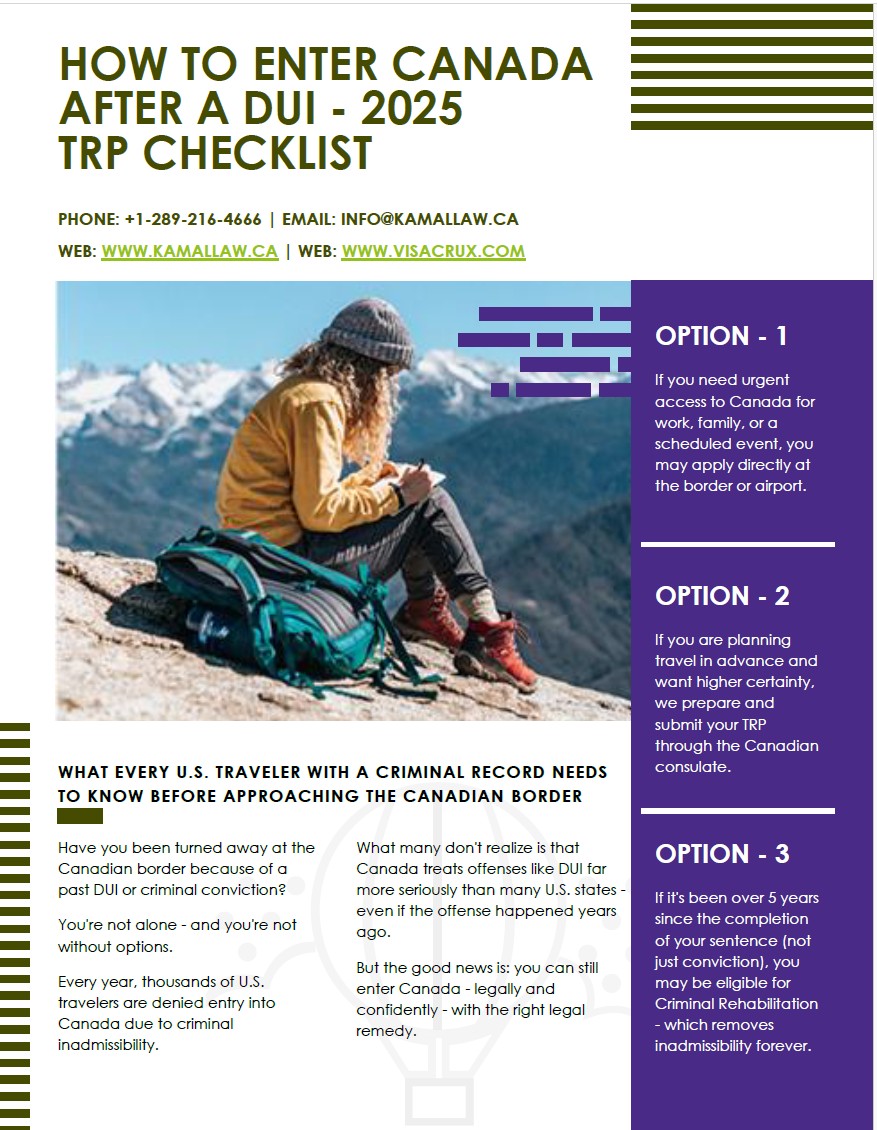Temporary Resident Permit (TRP) Canada – Complete 2025 Guide for Inadmissible Visitor

Your Trusted Resource for Overcoming Canadian Inadmissibility
By Kamal Akhtar, Canadian Immigration Lawyer | Last Reviewed: July 12, 2025
If you're a foreign national who has been deemed inadmissible to Canada, whether due to a past criminal conviction, medical issue, or immigration violation, a Temporary Resident Permit (TRP) may be your key to entering Canada legally.
This page is your complete guide to the Canada Temporary Resident Permit process in 2025, written by a Canadian immigration lawyer who helps clients like you every day.
1. TRP and Criminal Rehabilitation
2. Temporary Resident Permit (TRP)
3. Criminal Rehabilitation
4. How to Enter Canada with a DUI
5. TRP for DUI (Driving Under the Influence)
6. TRP Checklist 2025 (Free PDF Download)
Download the TRP Guide written by a Lawyer
Kamal Akhtar, Immigration Lawyer | Dec 2025

Kamal Akhtar is a Canadian immigration lawyer licensed by the Law Society of Ontario. Based in Ontario, Canada. Kamal has years of experience helping foreign nationals with immigration applications and appeals. He specializes in Canadian immigration law and other complex entry solutions. Kamal dedicates himself to delivering honest, strategic, and client-centered legal solutions for every case.
USA Phone: +1 (289) 216-4666 | Fax: +1 (289) 778-4745 | Email: info@kamallaw.ca
Whether you need to visit Canada for business, see family, or attend an emergency, this article will walk you through:
- ✅ What a TRP is
- ✅ Who qualifies
- ✅ How the application process works (Port of Entry vs. Consulate)
- ✅ What documents you need
- ✅ How to increase your approval chances
- ✅ Frequently Asked Questions—FAQs
You’ll also get expert insights, real examples, and access to a free downloadable TRP checklist to help you prepare like a pro.
1. What Is a Temporary Resident Permit (TRP)?
A Temporary Resident Permit is a special type of entry permission issued under section 24 of Canada’s Immigration and Refugee Protection Act (IRPA). It allows a person who would otherwise be inadmissible to legally enter Canada for a limited period, typically ranging from a few days to up to 3 years.
A TRP is discretionary, meaning there’s no guarantee of approval, and immigration officers weigh the risk you pose to Canadian society against the reason for your visit.
Inadmissibility reasons that may qualify for TRP include
- A past DUI (driving under the influence) or other criminal offense
- Past immigration violations
- Medical inadmissibility (rare, but possible)
- Security flags, in exceptional cases
Unlike a visitor visa, a TRP is specifically for those who are NOT otherwise allowed to enter Canada. It is your legal workaround to inadmissibility.
2. Who Qualifies for a Canadian Temporary Resident Permit?
A Temporary Resident Permit (TRP) is not for everyone. It’s specifically for people who would otherwise not be allowed into Canada due to legal, criminal, or immigration-related issues.
In Canadian immigration law, this is called being "inadmissible."
To be eligible for a TRP, you must meet two key conditions:
✅ 1. You Are Currently Inadmissible to Canada
The most common reasons include:
Criminal Inadmissibility
- DUI/DWI (Driving Under the Influence)
- Theft, assault, or other criminal convictions
- Drug-related offenses
Immigration Inadmissibility
- Past removal/deportation from Canada
- Overstayed a visa or permit
- Misrepresentation (false documents, fake job offer, etc.)
Medical Inadmissibility
- Conditions that could pose a public health risk or burden the health system (rare)
👉 If you're not inadmissible, you do not need a TRP; a standard visitor visa or eTA will usually suffice.
✅ 2. You Have a Valid and Compelling Reason to Enter Canada
Canadian immigration officers will only issue a TRP if they believe that your reason for coming outweighs the risks of letting you in.
This is known as the risk-vs-need test.
Commonly accepted reasons include:
- Attending a funeral or visiting a terminally ill relative
- Important business meetings, trade shows, or cross-border work
- Attending a wedding, birth, or family event
- Tourism, if your inadmissibility is minor and many years old
- Maintaining family relationships (e.g., Canadian citizen spouse or children)
What Doesn’t Qualify?
- You’re inadmissible and just want to come for vacation with no specific reason
- You’ve had recent criminal convictions and no rehabilitation period
- You’re applying without showing any risk reduction (no remorse, repeat behavior, no life changes)
➡️ The stronger your reason and the older/milder your offense, the better your chances.
✅ In the next section, we’ll break down how to apply, including whether to file at the border or through the consulate.
3) HOW TO APPLY FOR A TRP IN CANADA

How to Apply for a TRP in Canada: Two Main Methods
There are two ways to apply for a Temporary Resident Permit (TRP) depending on how urgently you need to enter Canada and where you're located:
✅ OPTION 1: Port of Entry (POE) Application
Best for: U.S. citizens or residents needing urgent or short-term entry
You can apply for a TRP directly at the border or airport when you arrive in Canada. This is called a Port of Entry (POE) application.
🔹 Pros:
- Fast decision — usually same day
- Ideal for urgent family visits, funerals, or business trips
- Often issued for short stays (1 day to 1 year)
🔹 Cons:
- Risky: If refused, you're denied entry on the spot
- Must have all documentation ready and organized
- No second chances once you’re at the border
To maximize your odds, we strongly recommend bringing:
- Legal submissions (letter explaining your case)
- Supporting documents (court records, rehab proof, invitation letters)
- Proof of travel intent and return
- Fee: CAD $239.75 (payable at POE)
✅ OPTION 2: Consulate/Visa Office Application
Best for: Planned trips more than 3 months in advance, longer stays, or multiple entries
This is a paper-based application submitted to the Canadian Consulate responsible for your home country (e.g., Los Angeles or New York).
🔹 Pros:
- Safer and more predictable
- Can result in multi-entry TRPs valid for 1–3 years
- Recommended if you’re applying with other family members or accompanying minors
🔹 Cons:
- Takes time (anywhere from 2 to 12 months)
- Paper-intensive process
- Requires patience and preparation
This is ideal for people who want to:
- Travel regularly for work or family
- Attend planned events in the future
- Avoid last-minute POE stress
✍️ How to Apply (Online or Offline)
To apply at the border:
- Prepare a border-ready TRP application binder
- Include supporting documents, payment, and a strong legal submission
- Arrive early, be respectful, and answer truthfully
To apply via consulate:
- Download the TRP application form (IMM5708) Prepare:
- Detailed explanation letter
- Police certificates
- Court documents (if applicable)
- Travel history
- Invitation or purpose letter from Canadian contact
Submit to the correct consulate with payment
📌 There is currently no "fully online TRP application "portal" even if you're applying in advance, documents must be submitted via physical mail or courier to the appropriate consulate.
💡 Want help preparing your TRP application? We offer a complete DIY kit, document review, and full-service representation, depending on your needs and budget.
✅ In the next section, we’ll walk through what documents you need to gather for a strong application.
4) REQUIRED DOCUMENTS FOR A TEMPORARY RESIDENT PERMIT

What Documents Do You Need for a TRP Application?
Whether you’re applying at the border (Port of Entry) or through a consulate, your Canada TRP application must be fully documented to stand any chance of success.
Below is a checklist of the core documents every Canadian Temporary Resident Permit application should include:
✅ Core Required Documents (All Applications)
Completed Application Form IMM 5708
➤ This is the main TRP application form used for both consulate and POE applications.
Detailed Explanation Letter (Legal Submission)
➤ A compelling written explanation of:
- Why you are inadmissible
- What has changed in your life since the offense
- Why you need to enter Canada now
- How you’ve demonstrated rehabilitation or stability
Police Certificate(s)
➤ FBI background check + local police certificate if applicable
Court Disposition Records
➤ Official records showing charges, convictions, fines paid, probation completion
Proof of Purpose of Visit
➤ For example:
- Invitation letter from family or business contact
- Death certificate or funeral notice
- Wedding invitation
- Event confirmation or conference registration
Travel History
➤ A list or proof of past travel (passport stamps, visas)
Proof of Ties to Your Home Country
➤ Employment letter, lease agreement, property deed, family dependents, etc.
Fee Payment Receipt
➤ CAD $239.75 (must be paid in full; non-refundable)
🧠 Bonus Supporting Documents (Strengthen Your Case)
Character References
➤ Letters from employer, community leader, or religious figure
Evidence of Rehabilitation
➤ AA/NA meetings, therapy, letters from counselors, community service records
Proof of Return Intent
➤ Return flight booking, letter from employer confirming return to work
📎 Tip from a Canadian Immigration Lawyer:
Most refusals happen because applicants either forget key documents or fail to explain their case persuasively. The TRP is not a formality; it’s a request for an officer to make a discretionary exception. We recommend presenting your case as you would a legal argument.
💼 Want a professional to review or prepare your TRP binder? Call 289-216-4666.
✅ In the next section, we’ll break down real-world examples of successful TRP cases, including one for a U.S. citizen with multiple DUIs.
5) How to Increase Your Chances of TRP Approval
Because a Temporary Resident Permit (TRP) is a discretionary approval — meaning an officer can say “yes” or “no” based on their judgment — it’s critical to present a strong, well-organized case.
Here are the top ways to boost your odds of success:
✅ 1. Be Honest and Transparent
Do not hide your inadmissibility or downplay your past offenses. Explain your criminal history openly and clearly. Misrepresentation (even by omission) almost always results in refusal and can lead to a future ban.
✅ 2. Show Evidence of Rehabilitation
Officers want to see that you’re no longer a risk to Canada. You can strengthen your case by including:
- A clean record since the offense
- Proof of completed probation or sentencing terms
- Evidence of sobriety or addiction recovery (e.g., AA/NA attendance)
- Letters from employers, therapists, or community leaders showing change
✅ 3. Demonstrate a Compelling Reason for Travel
The stronger your reason to visit Canada, the more likely a TRP will be granted. Valid reasons include:
- Family emergencies or important life events (funerals, weddings, births)
- Business travel or cross-border work
- Reuniting with a spouse or child
- Medical or humanitarian concerns
Support your reason with documents like:
- Invitations
- Travel itineraries
- Hotel bookings
- Proof of family ties in Canada
✅ 4. Present a Well-Organized Application
Don't just throw paperwork together. Officers appreciate clarity and professionalism. Include:
- A cover letter or legal submission explaining your situation
- Court records and police certificates
- A table of contents
- Clear labels and section dividers
This makes it easier for the officer to follow your story — and rule in your favour.
✅ 5. Get Professional Help
If you're unsure how to present your case, working with a Canadian immigration lawyer can dramatically improve your chances. A legal expert can structure your submission, prepare you for border questions, and avoid common mistakes that lead to refusal.
Remember: TRPs are about risk vs. need. Prove your need is real and your risk is low, and you'll be one step closer to entering Canada.
6. Common Questions (FAQs)
How long is a TRP valid for?
How long is a TRP valid for?
A: A TRP can be valid for as short as 1 day (for urgent travel) or up to 3 years, depending on your circumstances. Most Port of Entry TRPs are valid for under 1 year, while Consulate-issued TRPs may last longer and allow multiple entries. g reason for their visit, such as urgent medical treatment or critical business meetings.
Q2:
Can I work or study in Canada with a TRP?
Q2: Can I work or study in Canada with a TRP?
A. Not directly. A TRP only gives you entry permission. However, once inside Canada with a valid TRP, you may be eligible to apply for a work permit or study permit, depending on your situation.
Q3:
Is a TRP the same as criminal rehabilitation?
Q3: Is a TRP the same as criminal rehabilitation?
A: No. A TRP is temporary, allowing you to enter Canada despite being inadmissible. Criminal Rehabilitation is a permanent fix, wiping your inadmissibility. In many cases, people apply for both — using a TRP to enter now and Criminal Rehabilitation for the long term.
Q4:
Can I apply for a TRP online?
Q4: Can I apply for a TRP online?
A: No. While some documents can be downloaded or emailed, the actual TRP application must be submitted at a Canadian port of entry or via a consulate by mail.
How much does a TRP cost?
How much does a TRP cost?
The government fee is CAD$239.75, non-refundable. If you hire a lawyer or consultant, additional service fees apply.
By understanding these FAQs and the detailed information provided, individuals can better navigate the complexities of applying for a Temporary Resident Permit Canada and make informed decisions about their immigration plans.
Where to Find Resources?
To stay updated with the latest rules and regulations, application processes, forms, and other details about Canada temporary resident permit TRP or rehabilitation, consider visiting this government website: Temporary resident permits (TRPs).

Kamal Akhtar is a Canadian immigration lawyer licensed by the Law Society of Ontario. Based in Ontario, Canada. Kamal has years of experience helping foreign nationals with immigration applications and appeals. He specializes in Canadian immigration law and other complex entry solutions. Kamal dedicates himself to delivering honest, strategic, and client-centered legal solutions for every case.
Kamal's credentials include a Bachelor of Law (LL.B.) and a Master of Law (LL.M.) from Osgoode Hall Law School in Toronto. Kamal is a noted member of professional associations like the Canadian Immigration Lawyers Association (CILA), the Canadian Association of Professional Immigration Consultants (CAPIC), the Canadian Bar Association (CBA), and the Ontario Bar Association (OBA). Over 20 years of legal experience shape Kamal's insights.
Please note that the information provided on this website does not constitute legal or professional advice.
Phone: +1 (289) 216-4666 | Fax: +1 (289) 778-4745 | Email: info@kamallaw.ca



